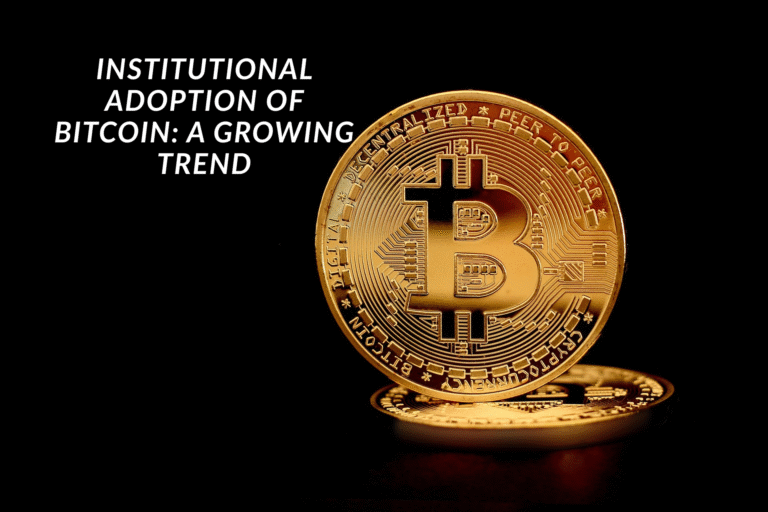Institutional Adoption of Bitcoin: A Growing Trend: As financial infrastructure develops and legal clarity increases, institutional adoption of Bitcoin is quickly accelerating. For the sake of diversification, inflation hedging, and long-term growth potential, businesses, hedge funds, and asset managers are progressively adding Bitcoin to their portfolios. The introduction of custodial services and spot Bitcoin ETFs has made access easier and drawn in conventional financial companies.
This change is highlighted by publicly traded firms like MicroStrategy and rising corporate treasury allocations. Institutional interest in Bitcoin is growing despite worries about volatility, regulatory uncertainty, and ESG issues. This indicates that Bitcoin has transformed from a speculative asset to a respectable part of mainstream finance and investment strategy.
Institutional Adoption of Bitcoin: A Growing Trend.

Institutional Adoption of Bitcoin: A Growing Trend: Since its conception, Bitcoin has frequently been perceived as a fringe asset: speculative, extremely volatile, with an ambiguous regulatory status, and typically the purview of libertarians, techies, and retail investors. But a big change has been taking place over the last few years. Bitcoin is becoming more and more popular among institutions, including banks, hedge funds, pension funds, asset managers, and public and private businesses. This shift signifies a new stage in the cryptocurrency’s development—from speculative interest to institutional asset.
What’s Driving Institutional Adoption.
-
Regulatory Clarity and Financial Infrastructure Improvements
Institutional Adoption of Bitcoin: A Growing Trend: Regulatory uncertainty has been one of the main obstacles to widespread institutional involvement in Bitcoin. Institutions favor well-defined regulations, supervision, and legal structures. Institutions are more confident that the risks are manageable as more jurisdictions make clear how cryptocurrencies and digital assets are handled, including taxation, anti-money laundering (AML), custody regulations, and reporting. This includes additional professional service providers for compliance, auditing, and risk management, specialized infrastructure (cold storage, multi-signature, audited providers), and improved custodial and custodial-insurance services.
-
Financial Products That Simplify Exposure
Institutions can obtain exposure to Bitcoin without having to retain and secure the asset directly by using products like spot Bitcoin Exchange-Traded Funds (ETFs), trusts, derivatives, and tokenized assets. By doing this, the operational, security, and custody issues that come with directly owning cryptocurrency are lessened. These products reduce risk and friction when they receive regulatory approval.
-
Portfolio Diversification, Inflation Hedge, and Scarcity
Bitcoin has certain features that make it appealing to institutions, such as having a fixed maximum supply (21 million coins), being non-correlated (or weakly correlated) with many traditional assets like stocks and bonds in some market regimes, and potentially serving as a hedge during periods of inflation or the depreciation of fiat currency. These characteristics appeal to businesses and asset managers who are concerned about macroeconomic instability or currency devaluation.
-
Macro‑economic and Geopolitical Pressures
Institutions are searching for assets beyond the traditional regime as a result of growing inflation pressures, monetary expansion, geopolitical risk, and currency devaluation concerns in various regions of the world. Bitcoin is a potential “store of value” in unpredictable situations since it is global, impervious to censorship, and largely unaffected by the actions of any one nation.
-
Better Market Liquidity and Institutional Knowledge
Bitcoin trading venues and market depth have improved over time. Friction can be decreased through increased research and data availability, improved risk systems, more professional traders, increased liquidity, and more. Additionally, many institutional investors now have crypto-savvy internal teams or outside consultants who assist with risk assessment, due diligence, metric comprehension, and strategy development.
-
Revised Accounting Standards
The way digital assets are recorded in business financial statements has changed in a few nations. For instance, there was a disincentive to keep when businesses could only report impairments (i.e., losses) on their cryptocurrency holdings and were unable to register gains until they were sold. Businesses might record value gains thanks.
Evidence of Rapid Growth.

Here are some concrete signs that institutional adoption isn’t just theory—that it’s accelerating:
- Public companies are increasingly adding Bitcoin to their treasury. For example, there are reports of over 35 public companies holding at least 1,000 BTC each.
- MicroStrategy remains one of the most prominent examples: with massive BTC holdings.
- The launch and rapid growth of spot Bitcoin ETFs: these vehicles have allowed large sums to flow into regulated investment channels.
- Surveys of institutional investors suggest increasing willingness to allocate a portion (often modest, e.g. 1‑5 %) of their assets to digital assets or Bitcoin. In many cases, more than half of surveyed institutions report plans to increase exposure.
- The total value of Bitcoin held by corporate treasuries (i.e. publicly disclosed reserves) has grown significantly, in some reports into the hundreds of billions of dollars.
- Benefits for Institutions.
Some of the reasons institutions see value in entering Bitcoin include:
- Potential for high returns: Bitcoin has had periods of dramatic appreciation, sometimes outperforming many traditional asset classes. If timed right (or over longer horizons), it can provide outsized returns.
- A hedge against inflation: Bitcoin’s fixed supply makes it attractive to those worried about the erosion of fiat currencies.
- Diversification benefits: Including assets with different risk‑return profiles helps reduce overall portfolio risk. Bitcoin, under many market conditions, has shown non‑perfect correlation with equities or bonds.
- Strategic PR and positioning: For some corporations and financial institutions, having crypto exposure signals modernity, forward thinking, and an ability to meet client demand, especially among younger or more technologically savvy investors.
- Access to new financial products: As the ecosystem matures, institutions can participate in earnings, staking (in other blockchains), derivatives, tokenization, etc., which can offer novel risk‑return opportunities.
Key Challenges and Risks.
Despite the momentum, there are still significant obstacles and risk factors for institutional adoption.
- Volatility.
- Whenever Bitcoin prices remain highly volatile. Sharp drops (or gains) can have material impacts on financial statements, risk profiles, or even reputational risk. Institutions must manage that risk through hedging or carefully scaling exposure.
- Regulatory and Legal Uncertainty.
- Even though regulatory clarity is improving, it is not uniform. Different countries have different laws. Changes in regulations (taxation, securities laws, custody laws, anti‑money laundering, etc.) can impact what is permissible or profitable. Regulatory risk remains non‑trivial.
- Custody, Security, Operational Risks.
- Managing private keys, preventing hacks, ensuring secure cold storage, insurance. Mistakes can be very costly. Institutions must rely on trustworthy custodians and strong internal controls.
- Accounting and Taxation Issues.
- How Bitcoin is treated on financial statements, how gains/losses are recognized, how transactions are taxed—these vary, and sometimes the rules are unfriendly (for instance when losses can be realized but gains cannot until sale, or when holding costs / depreciation / impairment complicate things).
- ESG / Environmental and Social Concerns.
- Because Bitcoin mining (proof of work) consumes significant energy, there are environmental criticisms. Institutions, especially in Europe or those with strong ESG mandates, may resist large positions unless there is assurance about sustainable energy usage, carbon footprint, etc.
-
Market Liquidity & Slippage.
Howerver For very large purchases or sales, markets may not always absorb trades easily without affecting prices. In some markets, liquidity is still shallow for very large institutional flows.
-
Perception, Reputation Risk, and Institutional Culture.
Whenever Bitcoin and crypto have had associations (sometimes unfairly) with illicit activity, fraud, hacks, scams. Also, internal culture may resist non‑traditional assets.
Outlook: Where Things Are Likely Headed.
Given the forces in play, several likely trends and implications emerge:
- Gradual mainstream acceptance: We can expect more banks, pension funds, sovereign wealth funds, endowments, and insurance companies to slowly increase exposure. Some will do so via ETFs or other regulated instruments; others may hold Bitcoin directly as part of treasury or reserve holdings.
- Increasing product sophistication: More refined financial tools: derivatives, options, hedging instruments, tokenization of Bitcoin or related assets, perhaps more services tailored to institutional needs (insurance, auditing, ESG certifications, etc.).
- More regulation and oversight: As institutional money flows in, regulators are paying more attention. We should expect more clarity, more rules about disclosures, custody, tax treatment.
- Potential impact on price dynamics & volatility: Institutional capital tends to have longer‑term horizons, which may reduce some short‑term volatility. But institutions are also rational and risk‑aware: they may push Bitcoin prices more as a function of macro risk.
Conclusion.
Bitcoin’s institutional adoption trend is genuine and growing; it is no longer merely a hunch. The growth of ETFs and other regulated financial products, increased infrastructure, improved regulatory clarity, macroeconomic pressures like inflation, and institutions’ desire for diversification are all contributing factors to Bitcoin’s acceptance as a part of many large portfolios and corporate treasuries.
Nevertheless, there are still significant concerns, including volatility, regulatory uncertainty, security/custody, and ESG demands. Institutions joining the market must proceed with cautious scale, thorough due diligence, and strong risk management.
it appears that the increasing institutional acceptance of Bitcoin will change the dynamics of the cryptocurrency. It might eventually result in improved stability in pricing, increased legitimacy, and deeper integration with the established financial system. The way that institutions, regulators.

